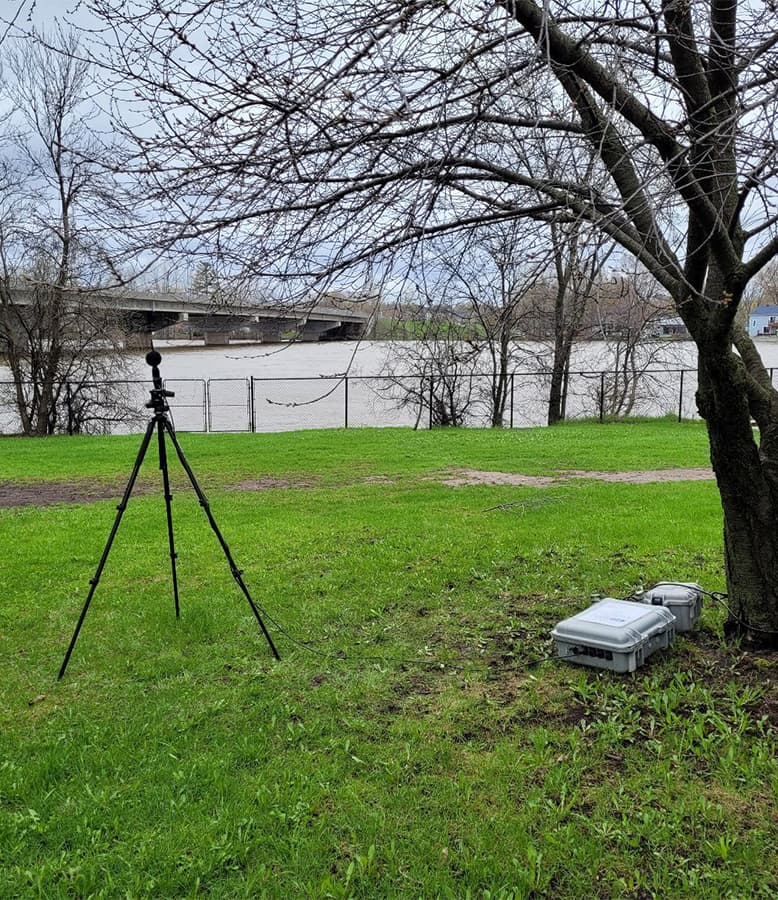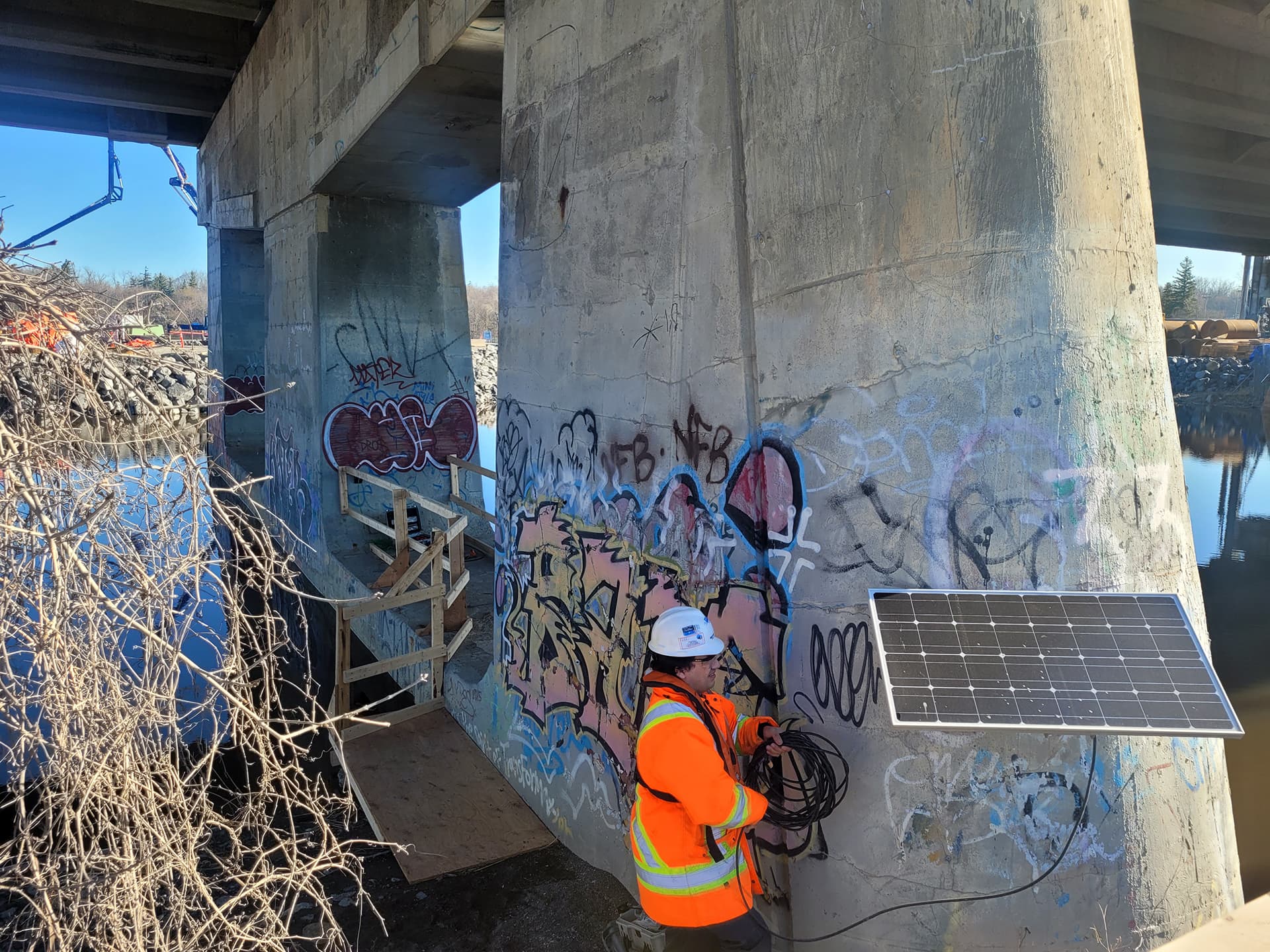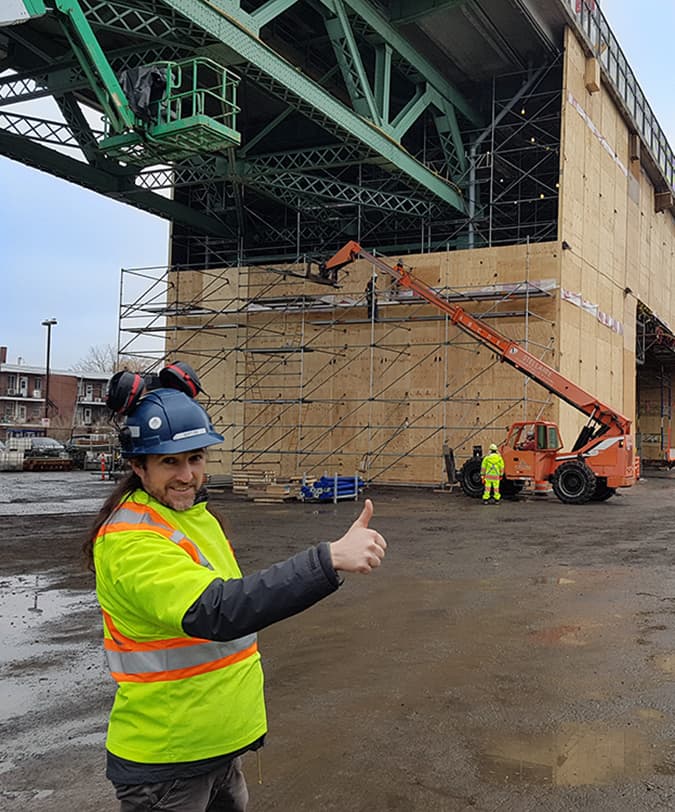Construction Noise Management Plan: Key Steps for Optimizing your Operations and Investments
Manage construction noise effectively with these key steps. Optimize your operations and increase the overall success of your project.
Request a quote
Construction Noise Management Plan: 4 Key Steps
For Construction Estimators and Project Managers
Noise control is an essential aspect of construction work. However, even though there are important steps that are necessary in order to achieve this, they are not always clearly outlined in the specifications of a project. Overlooking or ignoring the necessary steps can dramatically increase the risks of unexpected costs, delays in operation, and a lot of frustration!
Our experts in acoustics and vibration would like to share our proactive approach, with four (4) key steps for ensuring effective construction noise control.
Preliminary step
Before you start: Understand the requirements
Step 1
Survey ambient noise levels before construction begins
Step 2
Noise management
program
Step 3
Noise monitoring plan for construction sites
Step 4
Continuous noise monitoring during construction
Webinar Replay | Noise Management on Construction Sites
Effective noise control is essential for the success of any construction project, yet it is often underestimated or inadequately detailed in project specifications. Failing to address this crucial aspect can result in unforeseen expenses, project delays, and significant frustration!

Before you start: Understanding the requirements
A clear understanding of the requirements is important not only during the estimation period, but also during execution, as the stages and the operations to be followed during each phase can be impacted by them.
Before any project, it is therefore necessary to understand the noise limits to be respected. In general, the criteria come either directly from the estimate or from provincial reference documents such as: MTQ and MELCCFP.
The limits to be respected generally vary according to:
- The time (day/evening/night). The evening and night limits are more restrictive since the ambient noise (noise from construction site operations) is generally lower.
- The ambient noise (existing noise) before construction work. For example, in an environment where the ambient noise is higher, the limits to be respected are generally adjusted upwards.
- The noise criteria to be respected (LAeq, LAr, LAmax, L10%, etc.).
Beyond the levels to be respected, various specific details may be present in the requirements. The two most common elements to take into account in a regulation are:
- On what parameter is the criteria based?
Some acoustic indicators (LAeq, L10%) are data that can be directly measured by a sound level meter such as a Mezzo Class 1 Precision Microphone, allowing simple analyses to be carried out. However, some criteria require the consideration of corrective terms which, in order to be calculated, require post-processing, increasing the cost of the analyses. - The period of time to which these regulations apply.
There is a big difference between having to comply with an LAeq over a period of 30 minutes and over a period of 12 hours. Why? Because the longer the period, the more it will be possible to average the highest sound levels with those that are lower, thus rectifying the situation (1 compliance assessment every 12 hours).
In the case of short periods, such as 30 minutes, the time available to react is shorter, increasing the risk of exceeding the limit (this amounts to 24 compliance assessments in 12 hours!).

Survey Ambient Noise Levels Before Construction Begins
Surveying ambient noise levels prior to construction work is an imperative first step to managing noise control. This enables to ascertain the existing noise climate in sensitive areas around the jobsite, and particularly during night-time work. Noise limitations are typically a primary component in the specifications of a project, but in some cases, they are dependent on the existing noise levels in the environment, prior to the work as well.
|
What this means — If baseline noise measurements are not taken before construction work begins and the ambient noise is already quite high, you may find yourself in the position of having to unnecessarily stop construction activities to justify exceeding the limits, when technically there haven’t been any. With such a large operation and important deadlines to meet, any kind of delays can be quite costly — financially and productively. |
Understanding the Situation
In Ontario, the criteria for noise levels during construction can vary from one project to another.
Parameters can be set according to the existing noise levels in the area (adjacent to the project), or by a predefined limit, if the existing noise is low. In order to determine the noise limitations that will be required for the duration of the project, this is where establishing a baseline is particularly necessary.
For example, some Metrolinx projects that Soft dB has provided service for, had daytime residential noise parameters of “LAeq, 16 h from 7:00 am to 11:00 pm, and 75 dB(A)” or the “ambient level + 5 dB(A)”.
What Does This Mean for Your Particular Project?
When you take baseline measurements (prior to construction), and discover that the preliminary noise level in the environment is measuring higher than what was discussed in the estimate, your measured “ambient level + 5 dB(A)” then becomes your new reference limit to be respected.
Hypothetically, let's say your construction work takes place in a residential area during the day, and is also situated next to an active railroad track. If the baseline noise measurements produce a sound level of 80 dB(A), by using the “ambient level + 5 dB(A)” criteria, your construction site could then produce an allowable 85 dB(A), instead of the “set limit” of 75 dB(A).
What Are the Advantages of Carrying out Ambient Sound Surveys Prior to Construction Work?
By assessing the ambient noise climate, you will be able to determine and validate whether the pre-construction noise levels are accurate to those specified in the estimate.
It is important to note that without proper assessment, the levels indicated are only a ballpark representation of the area.
Conducting a baseline noise assessment will enable you to use concrete data to request a review, discuss potential unrealistic expectations, and then adjust the requirements of the estimate with the consultants involved.
By being proactive you can also avoid unpleasant complications, such as adjusting your work methods downwards, reducing the amount of work on site, and extending the time required to complete the mandate.
Take it from us.
→ A ballpark representation of noise levels is not accurate and using inaccurate values to manage the noise on your construction site, will place you more at risk of having to resort to costly and time-consuming reactive measures, versus being proactive with the correct data from the get-go!

|
Another concrete example to illustrate the importance of surveying ambient noise levels before starting work Let's assume that the ambient noise, prior to construction work, is 60 dB(A) and you make the decision to forgo conducting baseline measurements. Its important to note that all activity will be designed to comply with the limit predefined in the quotation, which may be 55 dB(A), for example. If you were to set up your microphone and then measure levels of 60 dB(A) due to adjacent road traffic noise, you would receive constant alerts indicating that the level, 55 dB(A), has been exceeded. You would then need to cease operations until you can demonstrate to the client that you are not responsible for these exceedances. Delays can pose significant complications, not to mention the potential for cost overruns. Trust us when we say — Taking ambient sound measurements BEFORE starting any construction work is not only beneficial, but its a smart move to be proactive and stay one step ahead! |
3 dB More = 2X More Noise, Therefore 2X More Construction Activity
Being Able to Generate an Additional 3 dB Is Equivalent to Doubling the Number of Pieces of Equipment on Site.
A Considerable Productivity Gain!
Let’s say that the estimated ambient noise level in the desired area is actually higher than the standard. Following the “ballpark levels” blindly, could mean that you are unnecessarily restricting your operations, and even the type of equipment being used. However, what if you had the opportunity to change the outcome?
→ Its amazing how a simple measurement of ambient sound levels prior to construction, can make all the difference in being able to optimize your operations.
In fact, adding 3 dB could be an absolute game changer for productivity.

Construction Noise Management Program
Did you know that a detailed noise management program can be used to simulate future work and identify critical phases and areas at risk of noise exceedance?
If risks are identified, the data used in the models can be refined by measuring the equipment to be used on site. These measurements at source ensure that the proposed treatments will be adequate, without being exaggerated.
A noise management program can save you a fortune!
By precisely identifying these at-risk zones and the sources of the exceedances, our acoustics experts can suggest the most effective mitigation measures to prevent the potential of stoppages/interruptions to construction activity.
Proactive planning helps to prevent noise complaints, maintain your construction activities, and plan the appropriate mitigation measures — to the benefit of all stakeholders.
A New Addition For Your Noise Management Program
To facilitate construction noise mitigation, Soft dB has developed a new turnkey solution of acoustic barriers to include in noise management programs.
Perfectly adapted to the evolving needs of construction sites, they can be installed and moved in no time, in addition to offering the best acoustic performance on the reusable screen market(STC 34).


Construction Noise Monitoring Plan
The strategy for noise monitoring on construction sites is outlined in the monitoring plan.
This approach ensures that all stakeholders are informed of the specific measures/plans that will be put in place to control construction noise levels, right from the beginning.
A construction noise monitoring plan comprises a number of elements, including the identification of positioning for surveying, using permanent acoustic monitoring stations, such as the Watch™ noise and vibration monitoring station, or spot measurements using portable instruments such as the Mezzo.
By installing stations before and during construction work, you'll actually be saving yourself the cost and time of moving and mobilizing stations.
Regulations often require noise monitoring stations to be on your site throughout the duration of the construction activity. Therefore, if you're going to require them anyway, installing them in advance will provide more benefits in the long run, including the comprehensive data that comes with it.

Continuous Construction Noise Monitoring
Continuous noise monitoring during construction is crucial for collecting accurate data in the event of regulatory limits being exceeded and/or noise complaints.
In the event of an exceedance, thanks to continuously recorded sound data, you'll be able to trace the exact moment when the exceedance occurred, listen to the audio recordings, correctly identify the problematic source, and implement effective corrective actions.
No more blind interventions!
Being able to know exactly what's causing the overruns, you can rectify the situation quickly and efficiently.
"Wait... You're saying that jobsite operations that are in compliance with regulatory noise limits, can still receive noise complaints?"
That's right. It may seem counter-intuitive at first glance, but it's actually an observed reality and a common misconception regarding noise. To find out more about the theory behind "Compliant, but audible", take a look at our experts' guide to mining noise.
The bottom line is that even if your activities are within noise limits, they may still generate noise that is perceived as disturbing to neighbouring communities, thus leading to complaints.
This is where the importance of continuously recorded sound data is critical.
In the event of complaints, you will be able to quickly identify whether your activities were the cause of the complaint or not.
This feature can become even more essential if your operations are in close proximity to another jobsite that has less stringent standards to comply with. Continuous monitoring would allow you to precisely determine what generated the complaint.
|
Remember: You are liable for noise disturbances, until proven otherwise. Having the precise data from continuous noise monitoring can be used as supportive evidence, to demonstrate and/or confirm that your site wasn’t the responsible party – thus saving you from any potential repercussions, such as costly penalties. |
Streaming Audio: An Asset for Construction Sites

Continuous audio allows you to "go back in time" to the exact moment when a disturbing construction noise was reported, which led to a complaint. All audio frames are recorded and therefore not dependent on an overrun alert in order to trigger audio recording – which is often the case with other monitoring systems.
Steaming audio is an asset for dealing quickly and effectively with construction noise complaints, and also your evidence to the contrary, in the event that you should need it.
At Soft dB, we work hard to support our clients by offering the best: high-performance, robust, and economical measuring instruments, such as the Watch™ Noise and Vibration Monitoring Station, which provides you with all the essential functions, including continuous audio.
What's more, Soft dB’s monitoring stations have the versatility and simplicity to provide you with more, for less!
Our system can also adapt to change, depending on what the project requires. For example, an acoustic monitoring station can be transformed into a vibration monitoring station, or even a hybrid station, simply by connecting the respective sensors.
With Soft dB's web-based monitoring platform, all collected data is centralized and can be managed in one single location, simplifying your life, and saving you time.
Versatile. Simple. Adaptable. Efficient.
The continuous noise monitoring equipment, as recommended by our experts, can offer you several essential features, such as:
- Sending automatic exceedance alarms (by text message and/or e-mail) to the various parties involved.
- Daily reports that indicate the date, location of readings, in addition to measured and authorized noise levels.
- The contractor can also enter the corrective actions taken in the event of exceedance.
- And much more.
Check out the Soft dB web monitoring platform to discover all the impressive features that it offers.

On-Site Technical Assistance — Optional and Available
Although this stage is optional, you will always have access to an expert Soft dB project manager who can assist you remotely and/or can be your "ears" on the job site.
At your request, and according to your specific needs, our team will be there to provide any assistance you may require, at any time — for assessments, implementation of noise mitigation measures, and even managing noise overruns.
What Are the Benefits of Technical Assistance?
When something unexpectedly happens on your job site and you need help fast, you can always count on us to help you with your noise and vibration challenges, so you can get back to business.
With over 25 years of practical experience and specialized knowledge in Acoustics and Vibration, our teams have likely already solved a similar challenge on another project. We’re happy to help!


Acoustical Assessment at the End of the Project — Optional and Available
As construction activity comes to a close, a post noise assessment can also be conducted, to close off/finalize the project regarding all noise and vibration.
Having a final report that documents the before, during, and after, can provide the complete picture, should this data be needed at a later time.
Just like the saying, “You get what you pay for…”, taking the proactive approach and investing a little extra on a more comprehensive, top-quality service can — and will — save you a lot of money (and headaches) in the long run.
Opting for high quality service can help give you peace of mind, along with the reassurance that your noise and vibration IS controlled — by experts in the field, from start to finish.
Did You Know?
For over 25 years, Soft dB has been Canada's leading private engineering firm, specialized in acoustics and vibration.
What does this mean for you?
Expect Superior Quality. Nothing Less.
→ Our people are your people.
You will always have the best acoustics and vibration experts fully dedicated to support you to achieve success for your project.
→ Our instrumentation is your instrumentation.
You will always have the latest and greatest instrumentation on the market, thanks to our world-class R&D team and their collaboration with our experts in the field. Our products and services will always represent the best solution for our clients.
We adapt to your needs, not the other way around.
At the Best Price.
By working directly with Soft dB as the manufacturer, you cut out the middleman in your chain of operations and can ensure that you’re receiving a high-quality product, for the best price.

In a Nutshell — Ensure the Most Effective Noise Control for Construction to Optimize Your Operations
Completing each of these important and effective steps in "Noise Control for Construction" is the key to optimizing your operations and maximizing your profitability:
- Survey ambient noise levels before construction begins.
- Design a high-quality noise and/or vibration management plan.
- Prepare and monitor your sound monitoring plan.
- Deploy the best sound monitoring solution in the field.
- Optional — Receive the necessary assistance on site.
- Optional — Close your “Construction Noise Control” project with a follow-up acoustical assessment report.
Put your trust in a team of experts, with over 25 years' of experience in acoustics and vibration.
We will help you avoid any potential challenges by proactively covering all your bases for efficient and effective noise control.

Invest in the Success of your Construction Project with Effective Noise Control
Without question, there is a lot of work that goes into managing all the aspects of a large construction project, especially when it comes to selecting the right subcontractors for the job. What we know (and what you know) is that when corners are cut to save on costs, quality tends to take a dive, thus costing more in the long run. Having to shut down a construction site over something that could have been easily avoided, is incredibly costly and not worth the financial and productivity loss. Our superior service, quality, and expertise will ensure that you won’t have to.
Request a quote